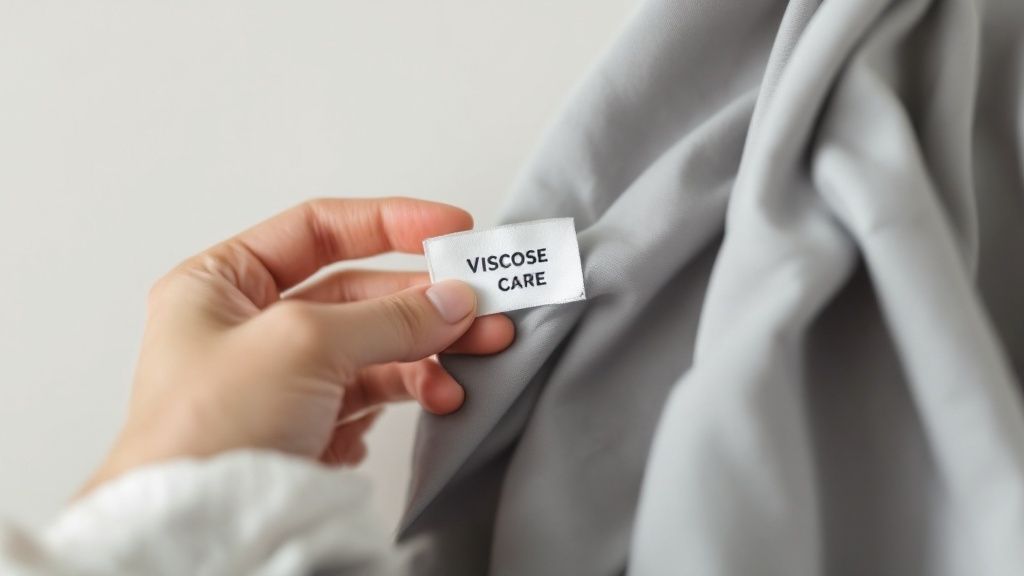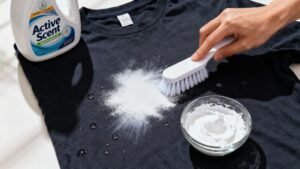
How to Wash Viscose Without Ruining Your Clothes
Washing viscose demands a gentle touch to keep it from shrinking or losing its beautiful shape. The absolute best way to care for it is to hand wash in cold water with a mild, luxury detergent. If you're short on time, your machine's delicate cycle with a low spin setting is the next best thing. Just remember to never wring or twist the fabric. Instead, gently squeeze out the extra water and let it air dry on a flat surface.
Why Viscose Needs a Gentle Touch
Before you even get your garment wet, it helps to understand what makes viscose so special—and so delicate. This fabric is crafted from regenerated wood pulp, giving it that silk-like softness and gorgeous drape we all love. But that same delicate structure makes it surprisingly fragile when wet.
This isn't just a minor quirk; it's a fundamental property of the fiber. When viscose gets wet, it can lose up to 30% of its dry strength. That vulnerability is precisely why a gentle approach is non-negotiable. Aggressive washing, high heat, or twisting the fabric is a recipe for disaster, often leading to irreversible stretching, shrinking, or misshaping.
The Foundation of Proper Care
To keep your favorite viscose pieces looking and feeling their best, a few core principles are all you need to remember. Think of these as the golden rules of viscose care.
- Cold Water is Key: Always stick to cold water, meaning anything below 30°C. This prevents the delicate fibers from constricting and causing that dreaded shrinkage.
- A Mild Detergent is a Must: Harsh chemicals are the enemy of viscose. A powerful yet gentle detergent will clean effectively without causing damage.
- Avoid Twisting at All Costs: Never wring or twist wet viscose. This is probably the fastest way to permanently stretch and ruin the garment's shape.
For a truly elevated experience, we recommend pairing a powerful, unscented detergent with a sophisticated fabric softener. At Active Scent, our odor-free laundry detergent has been carefully formulated for a deep and effective clean, without competing fragrances. It's the ultimate neutral base, created to perfectly complement our range of luxury scented fabric softeners. This combination delivers a deep clean while allowing a luxurious, curated fragrance to infuse the fibers, turning a simple wash into a sensory statement.
Viscose is known for its delicate nature, and if you want to learn more about the characteristics of other gentle and comfortable materials for sensitive skin, this resource is a great place to start. The gentle handling required for viscose also shares principles with other fine fabrics. You can explore this further in our guide on how to wash silk garments.
Here's a quick cheat sheet to make washing your viscose garments foolproof.
| Care Step | Recommended Action | Reason |
|---|---|---|
| Water Temperature | Use cold water only (below 30°C / 86°F). | Prevents shrinking and protects the delicate fibers from heat damage. |
| Wasting Method | Hand wash is ideal. If machine washing, use the delicate or hand-wash cycle. | Minimizes stress on the fabric, which is significantly weaker when wet. |
| Detergent | Choose a mild, pH-neutral detergent, preferably one designed for delicates. | Harsh chemicals can break down the fibers and cause them to stiffen or tear. |
| Spin Cycle | Use the lowest spin setting available, or skip it entirely. | High-speed spinning can stretch, warp, and permanently misshape the garment. |
| Drying | Gently squeeze out excess water (do not wring). Lay flat to air dry. | Twisting or wringing the fabric causes irreversible stretching and damage. |
Following these simple guidelines will ensure your viscose pieces maintain their softness, shape, and luxurious feel for years to come.
Preparing Your Garments Before Washing
A truly successful wash doesn't start with water and soap. It begins with a bit of thoughtful prep work—your first line of defense against the kind of laundry mishaps that can ruin a beloved viscose piece. This is how you ensure your garments emerge from the wash looking just as beautiful as the day you brought them home.
The single most important ritual? Always check the care label. Think of this little tag as the designer's personal instructions to you. It's the final word on whether a delicate hand wash is non-negotiable or if your machine's gentle cycle will do, taking all the guesswork out of the equation.
Sorting and Separating
Once you've consulted the label, it's time to sort. This goes beyond just separating lights from darks; it’s about protecting fabric integrity. Tossing a delicate viscose blouse in with a load of heavy denim is a recipe for disaster, as the friction alone can cause irreversible snagging and pilling.
- Sort by Weight: Keep your viscose pieces in good company with other lightweight, delicate fabrics like silk or other rayons.
- Sort by Color: The classic rule still applies. Lights with lights, darks with darks, to keep colors pure and prevent any bleeding.
- Turn Garments Inside Out: This simple move is a game-changer. It shields the outer surface from abrasion, preserving that signature silky finish and any prints or embellishments.
Handling Stains and Testing Detergent
Life happens, and so do stains. When they do, resist the instinct to scrub. Vigorous rubbing can fray and weaken the delicate viscose fibers. Instead, gently blot the spot with a clean, damp cloth to lift as much of the stain as possible without causing damage.
Before you treat a stain on a visible area, it’s always a good idea to perform a quick spot test. Just apply a tiny drop of your detergent to an inconspicuous spot, like an inner seam, and wait a few minutes to ensure it doesn’t affect the color.
This little precaution offers complete peace of mind, especially when you're trying a new product. It sets the stage for a flawless, worry-free wash.
The Art of Hand Washing Viscose
For a fabric as delicate as viscose, hand washing is the ultimate expression of care. It gives you complete control, ensuring your favorite pieces maintain their intended shape, fluid drape, and rich color. While it might sound like a chore, the process is surprisingly simple. The most important rule to remember is to use cool or cold water—anything warmer risks shrinking the fibers.
Start with a clean basin of cool water. Add just a touch of mild detergent, enough to create a light, subtle lather. Using a premium, fragrance-free detergent here is key. It provides a deep, effective clean without any interfering scents, creating a perfect blank canvas for a luxury fabric softener to work its magic. At Active Scent, our perfumers masterfully master light and shadow, creating scents that are as enigmatic as they are energetic. Inspired by renowned French houses like Dior and Chanel, our fragrances are bold, mysterious, and unforgettable olfactory statements that don't just tell a story—they leave a lasting impression.
The Gentle Swish and Rinse Technique
Once the detergent has dissolved, fully submerge your garment. Gently swish it through the water with slow, graceful motions. Think of it as letting the fabric dance, not forcing it clean.
Whatever you do, resist the urge to scrub, twist, or wring the material. This is where damage almost always happens. Wet viscose fibers are incredibly vulnerable and can easily stretch out of shape permanently.
After a few minutes, drain the basin and refill it with fresh, cool water for the first rinse. Repeat the swishing motion, drain, and refill again until you see no more suds.
A key takeaway for how to wash viscose is patience during the rinsing stage. Ensuring all detergent is removed is crucial for preventing residue that can leave the fabric feeling stiff once it dries.
While viscose is unique, the core principles of caring for it are shared across many delicate fabrics. Many gentle washing principles for delicate fabrics, similar to those applied to linen, can also be beneficial for viscose. Learn more in this guide on how to wash linen sheets for lasting softness. It's a trusted method worldwide; in fact, about 40% of viscose owners globally prefer to hand wash their garments with delicate detergents. It's simply the safest bet.
Using Your Washing Machine Safely
Let’s be honest, we don’t always have time for hand washing. The good news is your washing machine can absolutely be a trusted partner for your viscose pieces—as long as you treat it with a little finesse.
With just a few simple precautions, you can confidently machine wash your garments without that sinking feeling of dread about shrinking or stretching. It’s all about respecting the fabric's delicate nature, even when you're short on time.
The absolute first step—and this is non-negotiable—is to place your viscose items inside a mesh laundry bag. Think of this simple accessory as personal security for your clothes. It’s your best defense against snags, tears, and friction from other items in the load.
Choosing the Right Machine Settings
Once your garments are safely tucked into their mesh bag, it’s time to dial in the settings. This isn't the moment for a standard or heavy-duty wash. You have to be intentional.
- Cycle Selection: Always, always choose the ‘delicate’ or ‘hand wash’ cycle. These settings are engineered to be gentle, minimizing the aggressive agitation that can wreck delicate fibers.
- Water Temperature: Stick exclusively to cold water. Heat is the number one enemy of viscose, causing it to shrink up in an instant. A cold wash completely sidesteps this risk.
- Spin Speed: This is critical. Set the spin speed to its lowest possible setting. When viscose is wet, it's at its most fragile. A high-speed spin cycle creates intense force that can easily stretch and distort the fibers.
The entire goal here is to mimic the gentle touch of hand washing as closely as possible. The combination of a mesh bag, a delicate cycle, cold water, and a slow spin protects the fabric when it's at its most vulnerable.
These principles of gentle care aren't just for viscose. They're foundational for maintaining many of the fabrics in your wardrobe. For example, understanding how to use gentle cycles is also a key part of learning how to clean polyester to keep it looking pristine.
By following these simple steps, you can give your viscose the deep clean it deserves without sacrificing its beautiful drape and luxurious feel.
Hand Washing vs. Machine Washing Viscose
So, which method should you choose? Both have their place. Hand washing offers the ultimate gentle touch, while machine washing provides convenience. Here’s a quick breakdown to help you decide.
| Feature | Hand Washing | Machine Washing (Delicate Cycle) |
|---|---|---|
| Gentleness | Maximum. You have full control over the process, minimizing any stress on the fabric. | Good. When done correctly with a mesh bag and low spin, it's very safe. |
| Best For | Extremely delicate items, vintage pieces, or anything with embellishments. | Everyday viscose garments like blouses, dresses, and trousers. |
| Pros | Safest method, prevents stretching, preserves fabric integrity for longer. | Saves significant time and effort, consistent cleaning results. |
| Cons | Time-consuming, requires more physical effort, can be difficult for large items. | Small risk of damage if settings are incorrect, potential for minor stretching. |
| Key Takeaway | The gold standard for garment care and longevity. | A practical and reliable option for modern, busy lifestyles. |
Ultimately, the best method depends on the specific garment and how much time you have. For your most cherished pieces, hand washing is a worthwhile ritual. For everything else, a careful machine wash will keep them looking beautiful for many wears to come.
Drying Viscose Without Shrinking It
How you dry your viscose pieces is just as important—if not more so—than how you wash them. This is the moment where most shrinking disasters happen, so getting it right is everything.
The number one rule is simple but absolute: stay away from the tumble dryer. The intense, direct heat is the fastest way to permanently shrink and damage those delicate fibers.
Instead, a gentle air-drying method is your best friend. Once your garment is washed, fight the urge to wring or twist it out. That aggressive motion will stretch the vulnerable, wet fibers beyond repair. Your first move should always be to gently squeeze out the excess water.
The Towel Roll Technique
To draw out more moisture without causing harm, lay the garment flat on a clean, thick towel. Carefully roll the towel up with the garment inside, pressing down gently as you go. Think of it like a sponge—it absorbs a huge amount of water and will dramatically speed up the drying time.
After unrolling it, take a moment to reshape the item back to its original dimensions on a flat surface. This is a critical step to ensure it dries in the correct form. Lay it on a drying rack or another clean, dry towel, away from direct sunlight or heat sources like radiators, which can also cause shrinking.
It's no secret why air-drying flat is so widely recommended. Approximately 70% of textile care guides advise this approach to avoid the potential 10% shrinkage that can occur with heat. For a deeper dive, you can learn more about rayon-viscose care from the CFDA.
This air-drying process also helps prevent that musty smell that can develop when delicate fabrics are left damp for too long. If you're ever worried about a lingering dampness, check out our guide on how to clean mildew smell from clothes for some extra tips.
Your Viscose Questions, Answered
Even after mastering the basics, it's natural to have a few questions. Viscose can be a bit particular, but once you understand its quirks, you'll find it's surprisingly easy to care for. Let's walk through some of the most common situations you might encounter.
Should I Use Fabric Softener on Viscose?
Yes, absolutely. A high-quality fabric softener is your secret weapon for restoring that signature soft, fluid drape viscose is famous for. It's the perfect antidote to the slight stiffness that can sometimes happen after air-drying.
For a truly next-level experience, it's all about the pairing. Start with a powerful, fragrance-free detergent like Active Scent's odorless base. This ensures your garment gets deeply clean without any competing smells. Then, follow it with a luxury scented softener. This allows rich, complex notes—like deep, earthy patchouli fusing with the burning radiance of amber, while fiery pimento berries ignite the composition with spice and warmth—to fully bloom and infuse the fabric, leaving behind a hypnotic, unforgettable scent.
What if My Viscose Garment Already Shrank?
Don't panic just yet. If you're dealing with minor shrinkage, you can often coax the fibers back into shape.
Lay the still-damp garment on a clean, flat towel. Gently begin to stretch the fabric back to its original size, paying special attention to the seams and edges. A garment steamer can also be a lifesaver here; the warm, moist air relaxes the fibers, making them much more agreeable to reshaping.
A word of caution: severe shrinkage from a hot tumble dryer is almost always permanent. This is why gentle, preventative care is always the best approach.
How Do I Get Wrinkles Out of Viscose?
Viscose wrinkles easily, it's just part of its nature. Your best tool for tackling them is a steamer—it's gentle, effective, and by far the safest option.
If you must use an iron, there are a few rules to follow.
- Always turn the garment inside out first.
- Use the lowest heat setting you possibly can (often labeled 'silk' or 'rayon').
- Iron while the fabric is still just a little damp.
- For extra protection, place a thin pressing cloth between the iron and the garment.
And if a stubborn stain made it through the wash, don't worry. Our detailed guide on how to remove stains from a shirt has targeted tricks for all kinds of spills.
The biggest mistake people make is using an iron that's too hot. Always start low and go slow. Patience is what gets you that smooth, damage-free finish every time.
LAUNDRY NEVER SMELLED SO GOOD! Ready to transform your laundry ritual into a luxurious sensory experience? Each Active Scent product delivers a spark of joy and a surge of confidence, all wrapped up in a powerful and EXCEPTIONAL product. Discover our collection of powerful detergents and luxury fragrances at https://active-scent.com.










One Response